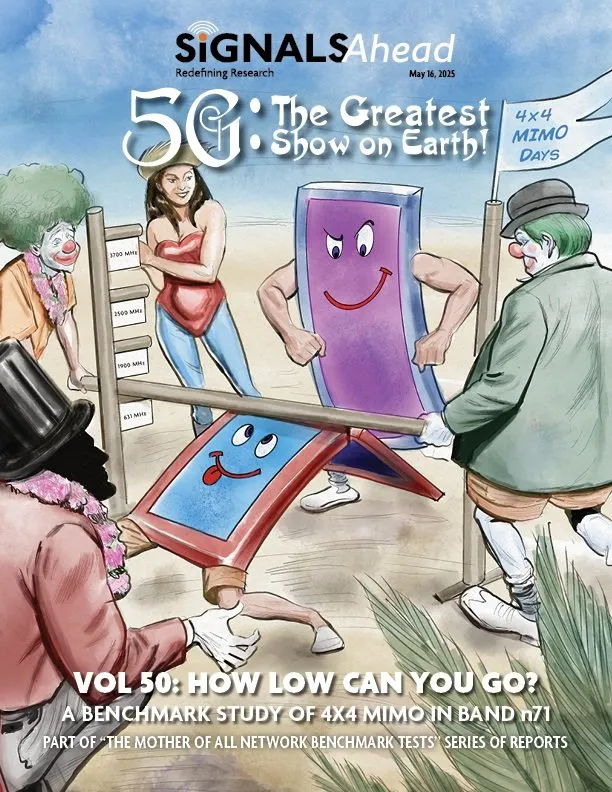5G、地上最大のショウ!:第50版 どこまで低く行ける?―600MHz帯(Band n71)の4×4 MIMO 実証ベンチマーク5G: THE GREATEST SHOW ON EARTH! Vol 50:How Low Can You Go? A Benchmark Study of 4x4 MIMO in Band n71 SRGは、50回目の5Gベンチマーク研究を完了した。今回は、Accuver Americas社およびSpirent Communications社と共同で、4×4 MIMO機能を搭載した5Gスマートフォンが商用Band n71 (631 MHz)ネット... もっと見る
サマリーSRGは、50回目の5Gベンチマーク研究を完了した。今回は、Accuver Americas社およびSpirent Communications社と共同で、4×4 MIMO機能を搭載した5Gスマートフォンが商用Band n71 (631 MHz)ネットワークでどのように動作するかのベンチマーク調査を行った。Nokiaがインフラ・サプライヤーを務めるミネアポリス郊外のT-Mobileのネットワークでは、非商用のMotorola製5Gスマートフォンを使用した。 レポートのハイライトは以下の通り: 謝辞 この研究は、Accuver Americas社とSpirent Communications社の協力を得て実施した。Accuver社からは、XCAL5ドライブ・テスト・ソフトウェアとXCAPポスト処理ソフトウェアを提供していただいた。チップセット診断メッセージの収集にはXCAL5を使用し、データの後処理とその後の解析にはXCAPを使用した。高帯域幅データ転送の生成には、Spirent Communications社のUmetrix Dataを使用した。両社は20年近くにわたり信頼できるパートナーである。SRGは、本レポートに記載されたすべての分析および解説に責任を負う。 背景 モトローラがBand n71で4×4 MIMOをサポートするRFフロントエンドを搭載した2種類の5Gスマートフォンを改良したことを知り、私たちはモトローラとT-モバイルに連絡を取り、Signals Aheadレポートのために実験用スマートフォンでその機能をテストできないか確認した。両社とも私たちの提案に同意してくれた。 方法論。2組のスマートフォン(フリップフォンとキャンディーバーのフォームファクター)を用意した。それぞれのペアにおいて、1台はBand n71で4×4 MIMOをサポートし、1台は従来の2Rx / 2×2 MIMOに制限されていた。各端末をBand n71(および比較のためBand n25)で単体でテストし、その結果を各ペアで分析し、4×4 MIMO機能がどのような利点をもたらすかを判断した。 分析 RB正規化ダウンリンク・スループット対SINR/RSRPを、4×4 MIIMO携帯電話が2MIMOレイヤー以上を使用している場合と使用していない場合にフィルタリングした結果で調べた。また、分析の一環として、データのジオビニング(3mグリッド)を使用した。また、携帯電話がより高いMIMOを使用する条件、その頻度、MCSのような他の測定基準への影響も分析した。 結果 すべてのデータポイントは、ローバンド5Gチャネルにおける4Rx / 4×4 MIMOが、ダウンリンク・スループットにおいて意味のある2桁の利得をもたらすことを示している。増加したスループットの大部分はダイバーシティの利得によるもので、平均すると、より高いMIMOレイヤーの使用による影響はごくわずかである。より高い5G FDD帯域におけるMIMOのプラスの影響もまた控えめであったが、この結果は部分的に、我々が議論する別の現象に起因している。次に何が起こるか?私たちがテストした携帯電話は、いわゆる「科学実験」かもしれないが、私たちは、ローバンド5G 4Rx/ 4×4 MIMOがそう遠くない将来にスマートフォンで一般的になると確信している。その利点を見過ごすのはあまりにも惜しい。
SummarySRG just completed its 50th 5G benchmark study. For this endeavor we collaborated with Accuver Americas and Spirent Communications to conduct a benchmark study of how 5G smartphones with 4×4 MIMO functionality perform in a commercial Band n71 (631 MHz) network. We used noncommercial Motorola 5G smartphones in T-Mobile’s network outside of Minneapolis where Nokia is the infrastructure supplier. Highlights of the Report include the following: Our Thanks. We did this study with the support of Accuver Americas and Spirent Communications. Accuver provided us with its XCAL5 drive test software and XCAP post-processing software. We used XCAL5 to collect the chipset diagnostic messages and we used XCAP for the post processing of the data and subsequent analysis. We used Umetrix Data from Spirent Communications to generate the high bandwidth data transfers. Both companies have been trusted partners with us for nearly two decades. SRG is responsible for all analysis and commentary provided in this report. The Background. After learning that Motorola had modified two different 5G smartphones with an RF front end that supported 4×4 MIMO in Band n71, we reached out to Motorola and T-Mobile to see if we could test the functionality in the experimental smartphones for a Signals Ahead report. Both companies agreed to our proposal and the rest, as they say, is history. The Methodology. We had two pair of smartphones (flip phone and candy bar form factors). Within each pair of phones, one phone supported 4×4 MIMO in Band n71 and one phone was limited to traditional 2Rx / 2×2 MIMO. We tested each phone by itself in Band n71 (and Band n25 for comparison purposes) and then analyzed the results within each pair to determine what, if any, benefit 4×4 MIMO functionality offered. The Analysis. We looked at RB normalized downlink throughput versus SINR/RSRP with results filtered into instances when the 4×4 MIIMO phones were and were not using more than 2 MIMO layers. We also used geo binning of the data (3×3 m grids) as part of our analysis. We also analyzed the conditions under which the phones used higher MIMO, how frequently it occurred, and the impact on other metrics, like MCS. The Results. All data points point toward 4Rx / 4×4 MIMO in a low-band 5G channel delivering meaningful double-digit gains in downlink throughput. Most of the increased throughput was due to diversity gains with very modest impact, on average, due to the use of higher MIMO layers. The positive impact of MIMO on higher 5G FDD bands was also modest, although the outcome partially stems from another phenomenon that we discuss. What Happens Next? Although the phones we tested may be what we would call “science experiments” we are convinced that low-band 5G 4Rx/ 4×4 MIMO will become commonplace in smartphones in the not-too-distant future. The benefits are too good to pass up.
ご注文は、お電話またはWEBから承ります。お見積もりの作成もお気軽にご相談ください。本レポートと同分野(無線・モバイル・ワイヤレス)の最新刊レポート
Signals Research Group社の 無線・モバイル・ワイヤレス分野 での最新刊レポート
本レポートと同じKEY WORD(5G)の最新刊レポート
よくあるご質問Signals Research Group社はどのような調査会社ですか?シグナルズリサーチグループ社(Signals Research Group)は、無線通信市場の調査とコンサルティングを行っている米国の調査会社です。「世界市場での存在感」「技術中心」「実践的なアプロー... もっと見る 調査レポートの納品までの日数はどの程度ですか?在庫のあるものは速納となりますが、平均的には 3-4日と見て下さい。
注文の手続きはどのようになっていますか?1)お客様からの御問い合わせをいただきます。
お支払方法の方法はどのようになっていますか?納品と同時にデータリソース社よりお客様へ請求書(必要に応じて納品書も)を発送いたします。
データリソース社はどのような会社ですか?当社は、世界各国の主要調査会社・レポート出版社と提携し、世界各国の市場調査レポートや技術動向レポートなどを日本国内の企業・公官庁及び教育研究機関に提供しております。
|
|







